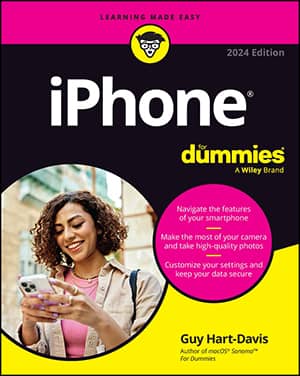The iPhone Home screen offers a bevy of icons, each representing a different built-in app or function. You first need to actually get to your iPhone's Home screen:
Press the Home button.
If your iPhone is asleep when you press, the unlock screen appears.
Move the on-screen slider to the right to unlock your iPhone.
After you unlock it, the iPhone displays whichever page of icons was on the screen when it went to sleep. If that happens to have been the Home screen, you're golden.
If a screen other than the Home screen appears, press the Home button again to summon your iPhone's Home screen.
After you get to your iPhone's Home screen, three steps let you rearrange the icons on your iPhone:
Press and hold any icon.
All the icons begin to jiggle.
Drag the icons around until you're happy with their positions.
Press the Home button.
This step saves your arrangement and stops the jiggling.
If you haven't rearranged your icons, the following apps appear on your Home screen, starting at the top-left:
Messages: Exchange text (SMS) and multimedia (MMS) messages with almost any other cell phone user.
Calendar: If you use iCal or Microsoft Entourage, Outlook, or Exchange, you can synchronize events and alerts between your computer and your iPhone.
Photos: View pictures that you took with the iPhone's built-in camera or transferred from your computer. You can zoom in or out, create slideshows, e-mail photos to friends, and much more.
Camera: Shoot a picture with the iPhone's 2-megapixel (iPhone and iPhone 3G), 3-megapixel (iPhone 3GS), or 5-megapixel (iPhone 4) camera. Ditto if you want to shoot video on the 3GS or 4 models.
YouTube: Watch videos from the popular YouTube Web site.
Stocks: Monitor your favorite stocks, which are updated in near-real time.
Maps: View street maps or satellite imagery of locations around the globe, or ask for driving, walking, or public transportation directions, traffic conditions, or even the location of a nearby pizza joint.
Weather: Get the six-day weather forecast for as many cities as you want.
Notes: Type notes while you're out and about. You can send the notes to yourself or anyone else through e-mail or just save them on your iPhone until you need them.
Utilities: A folder that contains four utility apps:
Clock: See the current time in as many cities as you want, set one or more alarms for yourself, and use your iPhone as a stopwatch or a countdown timer.
Calculator: Perform addition, subtraction, multiplication, and division.
Compass (iPhone 3GS and 4 only): Like having a magnetic needle compass inside your iPhone, but better.
Voice Memos: Turn your iPhone into a convenient handheld recording device.
The Utilities folder appears only on iPhones with iOS 4 preinstalled. iPhones that were upgraded to iOS 4 don't have a Utilities folder.
iTunes: Access the iTunes Store, where you can browse, preview, and purchase songs, albums, movies, and more.
App Store: Connect to and search the iTunes App Store for iPhone apps you can purchase or download for free over a Wi-Fi or cellular data network connection.
Settings: Adjust your iPhone's settings.
Phone: Use the iPhone as a phone. What a concept!
Mail: Send and receive e-mail by using most POP3 and IMAP e-mail systems and, if you work for a company that grants permission, Microsoft Exchange accounts, too.
Safari: Safari is your Web browser.
iPod: This icon unleashes all the power of a video iPod right on your phone.

